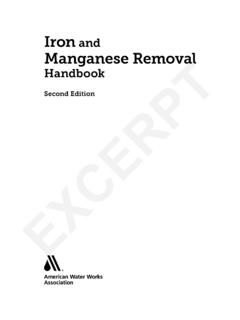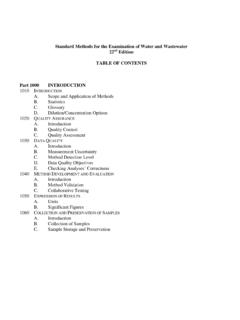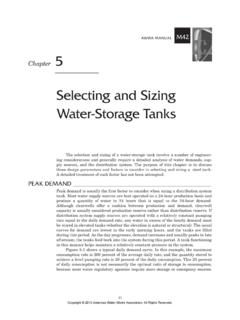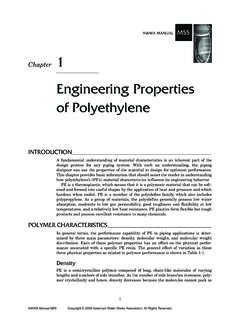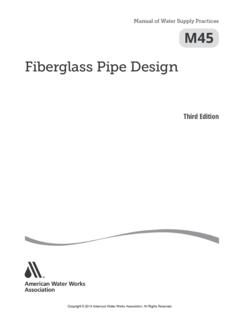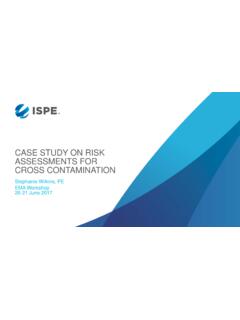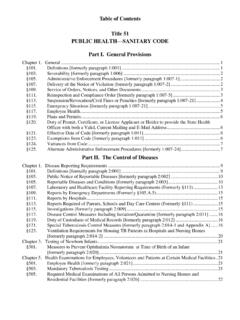Transcription of Backflow Prevention and Cross-Connection Control
1 Manual of Water Supply Practices M14. Backflow Prevention and Cross-Connection Control Recommended Practices Fourth Edition Copyright 2015 American Water Works Association. All Rights Reserved. Contents List of Figures, v List of Tables, vii Preface, ix Acknowledgments, xi Dedication, xiii Metric Conversions, xv Chapter 1 Introduction ..1. Purpose of Manual, 1. Responsibilities, 2. Health Aspects, 5. Legal Aspects, 7. Chapter 2 Back ow Prevention Principles ..11. Basic Hydraulics, 11. Types of Backflow , 13. Assessing Degrees of Hazard, 18. Assessing Other Risk Factors, 20. Assessing the Effectiveness of Assemblies and Devices, 21. Chapter 3 Program Administration ..23. Developing a Cross-Connection Control Program, 24. Types of Programs, 25. Management Programs, 28. Documentation, 33. Human Resources, 33. Program Administration, 35. Chapter 4 Back ow Prevention Assembly Application, Installation, and Maintenance ..41. Means of Preventing Backflow , 42.
2 Backflow Prevention Devices, 42. Method for Controlling Backflow , 59. Field Testing, 61. Reference, 64. Chapter 5 Conducting a Cross-Connection Control Survey ..65. Authority and Responsibilities, 66. Purpose of a Cross-Connection Control Survey, 66. Assessing the Degree of Hazard, 67. Survey Considerations and Concepts, 67. Conducting the Survey, 69. Reference, 74. Chapter 6 Sample Hazards and Proper Protection ..75. Typical Hazards, 76. Hazards Posed by a Water Supplier, 84. Protection for Specific Customers, 89. References, 91. AWWA Manual 14 iii Copyright 2015 American Water Works Association. All Rights Reserved. Backflow Prevention AND Cross-Connection Control . Appendix A Example Notices and Letters, 93. Appendix B Testing Procedures or Methods, 99. Appendix C Industry Resources, 181. Appendix D Incidents Tables, 183. Glossary, 187. Index, 193. List of AWWA Manuals, 203. iv AWWA Manual M14. Copyright 2015 American Water Works Association. All Rights Reserved.
3 AWWA MANuAL. M14. Chapter 1. Introduction For millennia, people have been concerned with obtaining and maintaining pure and safe water supplies. Archeological studies reveal that as early as 3000 BC, the ancient Egyptian State had a government official who was required to inspect the country's water supply every 10 days. With the widespread use of water closets in the 1800s came direct cross - connections with water mains. This brought into focus the problem that, as one nine- teenth century authority stated, foul matters may get into the pipes. * Currently, many government and industry professionals are aware of the need to prevent contamination of potable water supplies through cross -connections. However, the water supplier goals and levels of involvement may vary. PURPOSE OF MANUAL. This manual provides guidance to all professionals working with the potable water supply on the recommended procedures and practices for developing, operating, and maintain- ing an efficient and effective Cross-Connection Control program.
4 The manual also provides insight into the basic areas that should be addressed to ensure that public water system connections are made safely; that those connections will be operated and maintained to ensure water quality; and that public water suppliers have the basic knowledge needed to assist in this effort. The purpose of any such program is to reduce the risk of contamina- tion or pollution of the public water system. A Cross-Connection is an actual or potential connection between any part of a potable water system and an environment that would allow substances to enter the potable water system. Those substances could include gases, liquids, or solids, such as chemicals, water products, steam, water from other sources (potable or nonpotable), and any matter that may change the color or taste of water or add odor to water. * Keenan, , Section AWWA Cross-Connection Control , September 1977. 1. Copyright 2015 American Water Works Association. All Rights Reserved.
5 2 Backflow Prevention AND Cross-Connection Control . RESPONSIBILITIES. The United States Safe Drinking Water Act (SDWA) became law in 1974. The purpose of the act is to protect public health by regulating all public drinking water supplies in the United States. SDWA was amended in 1986 and again in 1996. As amended, it requires pro- tection of the public drinking water supply and its sources: both surface water and ground water. SDWA does not, however, regulate private wells serving fewer than 25 individuals and it also does not regulate systems having fewer than 15 service connections. SDWA authorizes the United States Environmental Protection Agency (USEPA) to set national health-based standards for public drinking water. These standards have been established to protect against naturally occurring and man-made contaminants that may be found in our drinking water supply. Together the USEPA, state regulatory agencies, and water suppliers work to make sure these standards are monitored and followed.
6 In Canada, provincial governments have jurisdiction over the public health aspects of the drinking water supply. Local governments within a province ( , regional districts and municipalities), with the authority of the province, may impose other regulations or more stringent regulations not in conflict with provincial regulations. Because there is a difference between the authority of the United States federal gov- ernment and that of Canada, and between the different states and provinces, the following discussion, although referring to federal and state, illustrates the different regulations governing a public water supplier. For US water utilities (public water suppliers), SDWA regulations govern PWSs. SDWA (see 42 300f(4)(A)) states: The term public water system [PWS] means a system for the provision to the public of water for human consumption through pipes or other constructed conveyances, if such system has at least fifteen service connections or regu- larly serves at least twenty-five individuals.
7 The public water system includes any collection, treatment, storage, and distribution facilities under Control of the operator of such system. SDWA states that water suppliers are only responsible for the water quality deliv- ered to the water consumer's service connection. In many jurisdictions, this is commonly referred to as point of entry or point of service. The water supplier is not responsible for contaminants and/or pollutants that are added to the potable water by any circumstances under the Control of the consumer beyond the public water supply water point of entry. Currently, SDWA provides that the federal government may grant the state or local governments primacy for the administration and enforcement of the federal drink- ing water rules and regulations. Agencies that have been granted primary enforcement responsibilities must adopt drinking water regulations that are at least as stringent as the current federal drinking water rules and regulations.
8 In addition to adopting the federal drinking water rules and regulations, primacy agencies may adopt additional or more stringent drinking water rules or regulations as long as the rules or regulations are not in conflict with SDWA and/or other federal rules or regulations. Thus, in states that have primacy, Cross-Connection Control rules are state adopted. Similarly, local government such as counties and cities, with the authority of the state, may also adopt additional or more stringent rules and regulations as long as the counties and cities are not in conflict with the state law or regulations. Both federal and state/provincial governments regulate the public health aspects of drinking water in order to protect the health, safety, and welfare of the water consumer. From the point of service/entry, federal, state, and local responsibilities to protect the health, safety, or welfare of the users of water are under the jurisdiction of agencies other than those regulating PWSs, and include, but are not limited to, the following: AWWA Manual M14.
9 Copyright 2015 American Water Works Association. All Rights Reserved. Introduction 3. Local plumbing and building officials who are responsible for enforcing all pro- visions of applicable plumbing and building codes relative to the installation, alteration, repair maintenance, or operation of all plumbing system devices and equipment including cross -connections on all new construction or any project that has plumbing or any building that has a construction, plumbing, or build- ing permit open. In such cases, the local code official will make all the required inspections or they may accept reports of inspection by approved agencies or indi- viduals. Plumbing codes provide for point-of-use Backflow protection for potable water systems. The local code officials usually have limited or no jurisdiction over any pre-existing structures. Fire marshals who are responsible for regulating fire protection systems ( , fire sprinkler systems) downstream of the potable water system supply connection entering the premises.
10 Safety inspectors (Occupational Safety and Health Administration [OSHA]; Work- ers' Compensation Board [WCB] [Canada]; Mine Safety and Health Administrators [MSHA]) who are responsible for inspecting potable water systems (plumbing) for workers' safety. Health officials who are responsible for inspecting restaurants and other food preparation facilities ( , dairies), health care facilities ( , nursing homes), etc. Agricultural inspectors who are responsible for the safe handling of chemicals ( , pesticides) used in growing and processing agricultural products. These agencies have jurisdiction over work done on the customer's premises. Most have regulations that involve Cross-Connection Control , and these different regulations may be in conflict with the procedures for Cross-Connection Control recommended in this manual. The authority of these agencies over the water supplier's customers may be con- tinuing or may be limited by the issuance of a final permit ( , for building occupancy).

